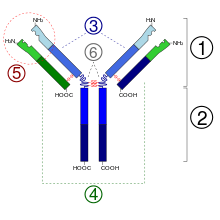Paratope

2. Fc region
3. Heavy chain
4. Light chain with one variable (VL) and one constant (CL) domain
5. Fv region with paratope
6. Hinge regions
A paratope, also called an antigen-binding site, is a part of an antibody which recognizes and binds to an antigen. It is a small region (of 5 to 10 amino acids) of the antibody's Fv region, part of the fragment antigen-binding (Fab region), and contains parts of the antibody's heavy and light chains.[1] Each arm of the Y shape of an antibody monomer is tipped with a paratope, which is a set of complementarity determining regions.
The part of the antigen to which the paratope binds is called an epitope. This can be mimicked by a mimotope. The figure given on the right hand side depicts the antibody commonly found on a B leukocyte. The engraved inner portions of idiotype (encircled region no.5) is the paratope where the epitope of the antigen binds.